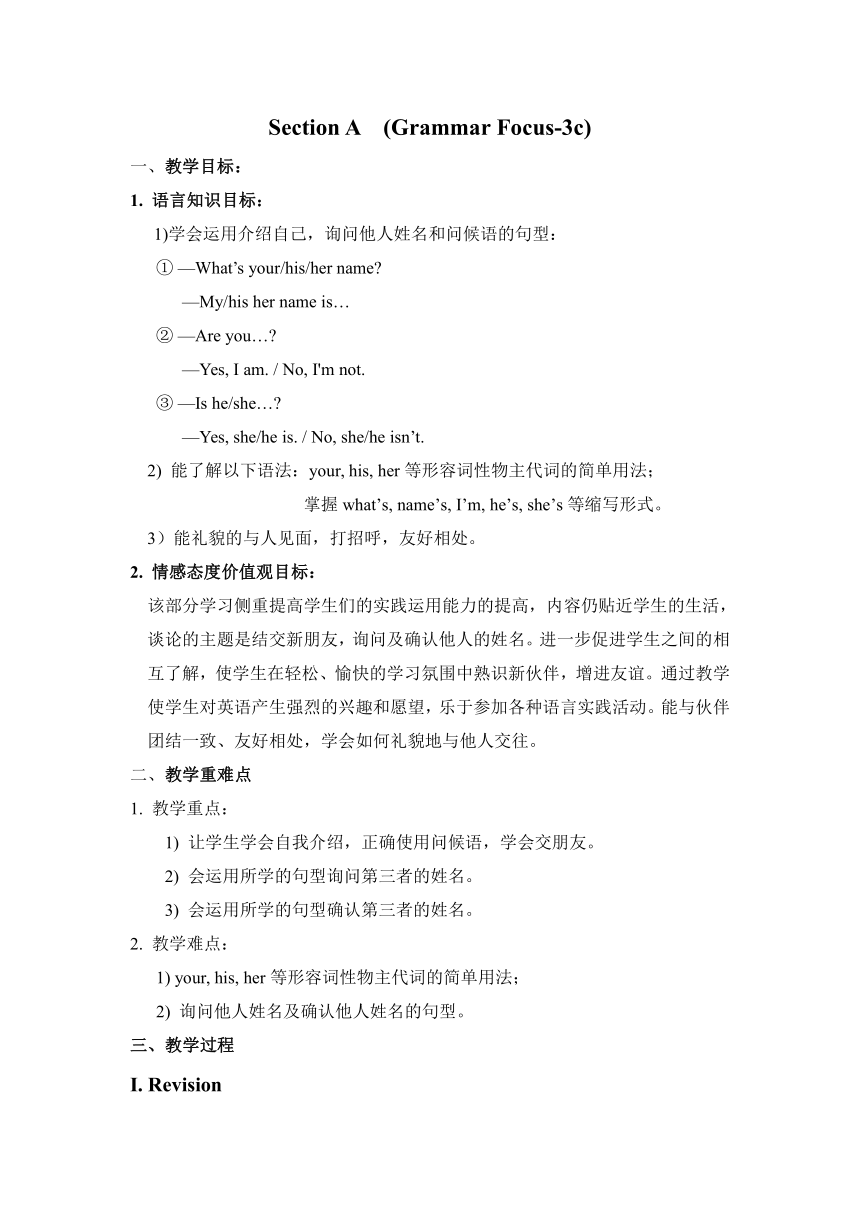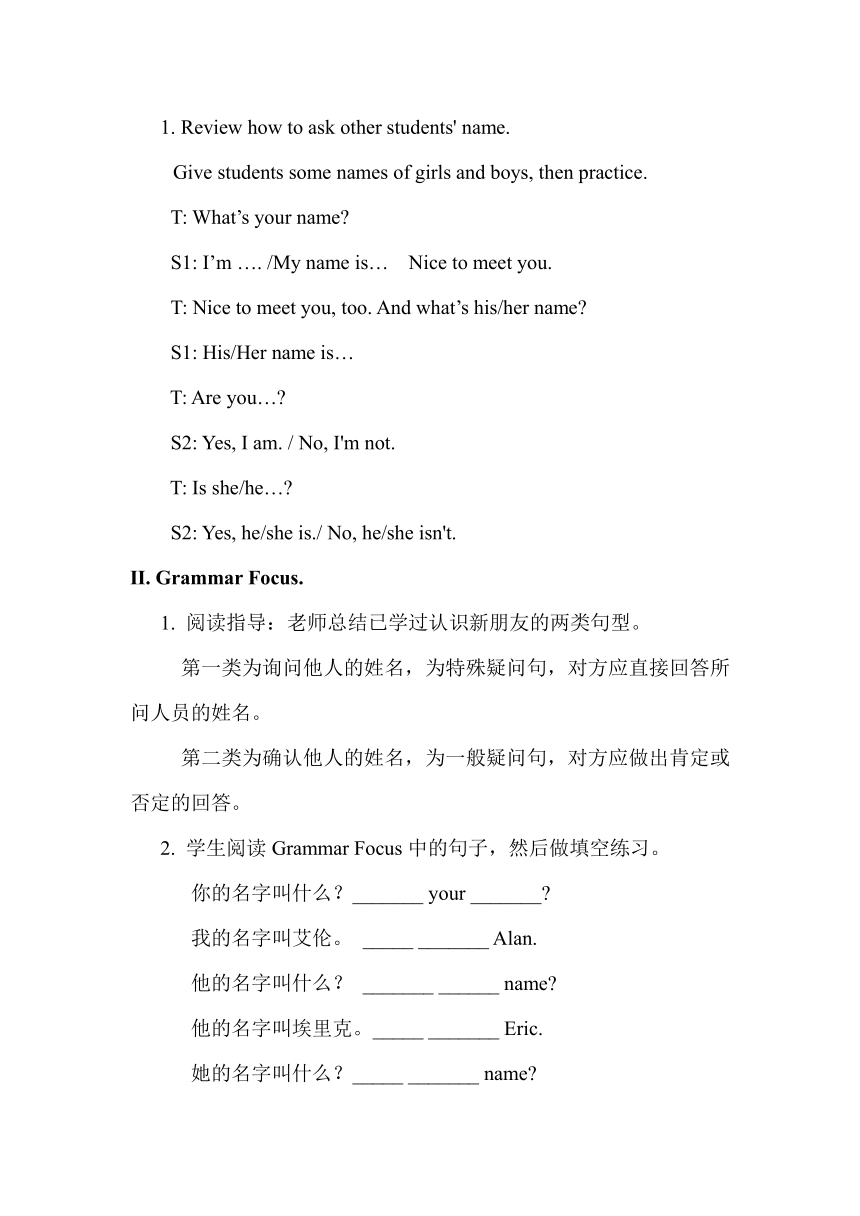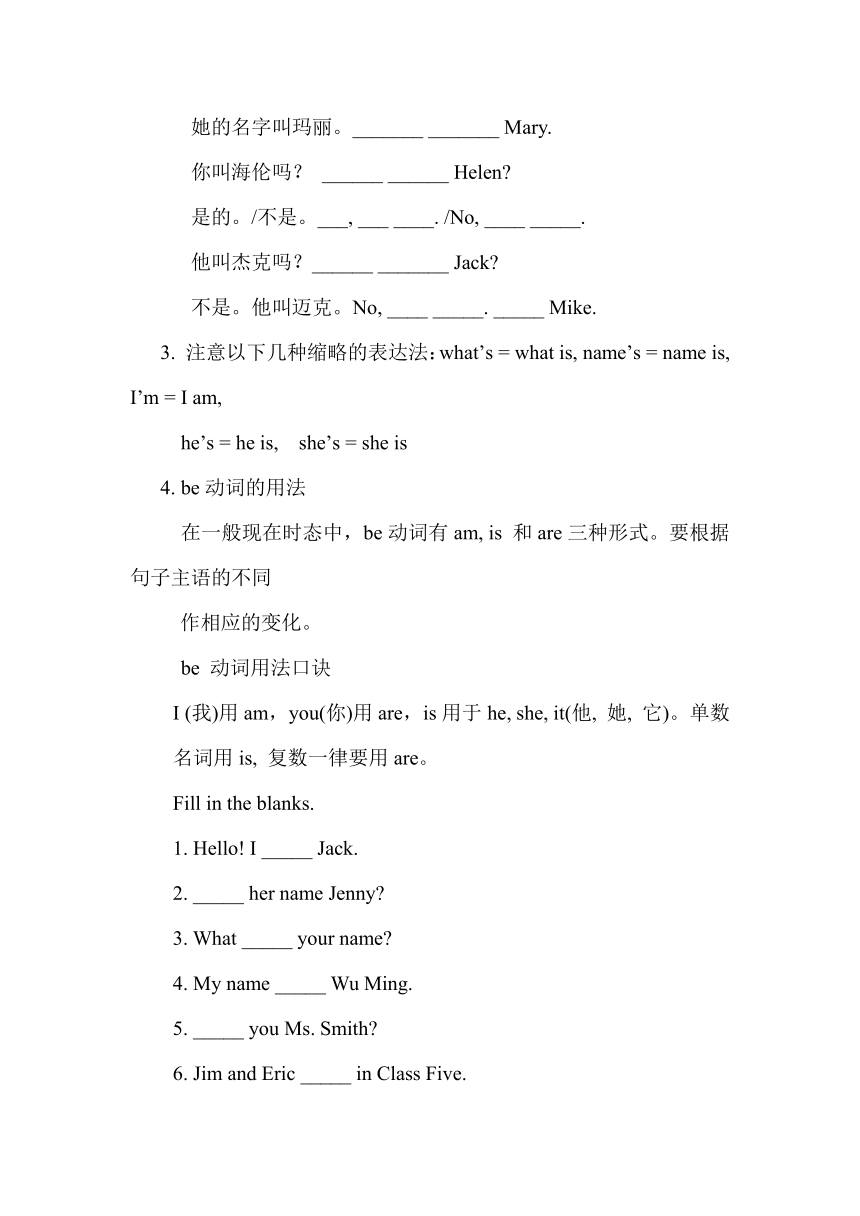人教版七年级上册 Unit1 My name's Gina. SectionA Grammar focus 3a-3c 教案
文档属性
| 名称 | 人教版七年级上册 Unit1 My name's Gina. SectionA Grammar focus 3a-3c 教案 |  | |
| 格式 | doc | ||
| 文件大小 | 40.5KB | ||
| 资源类型 | 教案 | ||
| 版本资源 | 人教新目标(Go for it)版 | ||
| 科目 | 英语 | ||
| 更新时间 | 2022-10-14 10:56:18 | ||
图片预览



文档简介
Section A (Grammar Focus-3c)
一、教学目标:
1. 语言知识目标:
1)学会运用介绍自己,询问他人姓名和问候语的句型:
① —What’s your/his/her name
—My/his her name is…
② —Are you…
—Yes, I am. / No, I'm not.
③ —Is he/she…
—Yes, she/he is. / No, she/he isn’t.
2) 能了解以下语法:your, his, her等形容词性物主代词的简单用法;
掌握what’s, name’s, I’m, he’s, she’s等缩写形式。
3)能礼貌的与人见面,打招呼,友好相处。
2. 情感态度价值观目标:
该部分学习侧重提高学生们的实践运用能力的提高,内容仍贴近学生的生活,谈论的主题是结交新朋友,询问及确认他人的姓名。进一步促进学生之间的相互了解,使学生在轻松、愉快的学习氛围中熟识新伙伴,增进友谊。通过教学使学生对英语产生强烈的兴趣和愿望,乐于参加各种语言实践活动。能与伙伴团结一致、友好相处,学会如何礼貌地与他人交往。
二、教学重难点
1. 教学重点:
1) 让学生学会自我介绍,正确使用问候语,学会交朋友。
2) 会运用所学的句型询问第三者的姓名。
3) 会运用所学的句型确认第三者的姓名。
2. 教学难点:
1) your, his, her等形容词性物主代词的简单用法;
2) 询问他人姓名及确认他人姓名的句型。
三、教学过程
Ⅰ. Revision
1. Review how to ask other students' name.
Give students some names of girls and boys, then practice.
T: What’s your name
S1: I’m …. /My name is… Nice to meet you.
T: Nice to meet you, too. And what’s his/her name
S1: His/Her name is…
T: Are you…
S2: Yes, I am. / No, I'm not.
T: Is she/he…
S2: Yes, he/she is./ No, he/she isn't.
Ⅱ. Grammar Focus.
1. 阅读指导:老师总结已学过认识新朋友的两类句型。
第一类为询问他人的姓名,为特殊疑问句,对方应直接回答所问人员的姓名。
第二类为确认他人的姓名,为一般疑问句,对方应做出肯定或否定的回答。
2. 学生阅读Grammar Focus中的句子,然后做填空练习。
你的名字叫什么?_______ your _______
我的名字叫艾伦。 _____ _______ Alan.
他的名字叫什么? _______ ______ name
他的名字叫埃里克。_____ _______ Eric.
她的名字叫什么?_____ _______ name
她的名字叫玛丽。_______ _______ Mary.
你叫海伦吗? ______ ______ Helen
是的。/不是。___, ___ ____. /No, ____ _____.
他叫杰克吗?______ _______ Jack
不是。他叫迈克。No, ____ _____. _____ Mike.
3. 注意以下几种缩略的表达法:what’s = what is, name’s = name is, I’m = I am,
he’s = he is, she’s = she is
4. be动词的用法
在一般现在时态中,be动词有am, is 和are三种形式。要根据句子主语的不同
作相应的变化。
be 动词用法口诀
I (我)用am,you(你)用are,is用于he, she, it(他, 她, 它)。单数名词用is, 复数一律要用are。
Fill in the blanks.
1. Hello! I _____ Jack.
2. _____ her name Jenny
3. What _____ your name
4. My name _____ Wu Ming.
5. _____ you Ms. Smith
6. Jim and Eric _____ in Class Five.
5. 人称代词和物主代词
“我” I; “你” you; “他” he; “她” she; “它” it; “你们” you; “我们” we; “他们”they
称为人称代词,在句子中作主语。
1. 我是一个男孩。_____ am a boy.
2. 你是琳达。______ are Linda.
3. 她是玛丽。______ is Mary.
4. 它是我的小狗汪汪。 ___ is my dog Wangwang.
5. 我们在五班。 _____ are in Class Five.
6. 你们在四班。_____ are in Class Four.
7. 他们在六班。_____ are in Class Six.
“我的” my;“你的” your;“他的” his;“她的” her表示所有关系的代词叫物主代词。
表示所有关系的代词叫物主代词。形容词性物主代词在用法上与形容词相似,表示“……的”。一般放在名词前修饰名词。
1. I’m Jack. ______ schoolbag is red.
2. He is Eric. _____ jacket is blue.
3. You are Mary. ______ pencil is black.
4. She is Grace. ____ cup is purple.
5. It is my dog. ___ name is Wangwang.
6. 人称代词主格和物主代词
1. ___ am a girl. ___ name’s Jenny. (my, I )
2. — What’s ___ name — Jack. (he, his)
3. — Is ___ Linda (she, her)
— No. ____ name’s Grace. (she, her)
4. — Are ____ Eric (your, you)
— Yes, __ am. (I, my)
5. — What’s ____ name (your, you)
— ___ name’s Bob. (I, my) _____ name’s Mike and ___ name’s Gina. (her, his)
Ⅲ. Practice I
1. Look at 3a. Tell Ss to put the words in order to make conversations. Pay attention to the right sentence structure. Ss work with their partners. Try to make conversations with the given words.
2. Check the answers. Encourage some pairs to act out the dialogue. See if their dialogues are right.
3. Ss read the dialogue aloud after the teacher. Then try to practice the dialogues with their partners.
4. Let some pairs to act out the dialogue in front of the class.
Ⅳ. Practice II
1. Look at 3b. Tell Ss to complete the conversation. Pay attention to the right sentence structure. Ss work with their partners. Try to make conversation.
2. Check the answers. Encourage some pairs to act out the conversations. See if their answers are right.
3. Ss read the conversations aloud after the teacher. Then try to practice the conversations with their partners.
4. Let some pairs to act out the conversations in front of the class.
Ⅴ. Game
1. Now, each of you has an English name. So we have learnt many names about boys and girls. Do you know how many foreign names Let's do a "Name game".
Competition: list names as many as possible, see which group gets the most names.
2. Divide the Ss into groups of six or more. Each group has four or six students.
3. Tell Ss how to play the game. Make a model for the Ss.
S1: My name is Jenny.
S2: Her name is Jenny. My name is Tony.
S3: Her name is Jenny. His name is Tony…My name is June.
S4: …
4. Ss play the game in their groups first. Then have a competition. See which group is the best.
Ⅵ. Exercises
1. If time is enough, let the students do more exercises.
2. Do the workbook.
一、教学目标:
1. 语言知识目标:
1)学会运用介绍自己,询问他人姓名和问候语的句型:
① —What’s your/his/her name
—My/his her name is…
② —Are you…
—Yes, I am. / No, I'm not.
③ —Is he/she…
—Yes, she/he is. / No, she/he isn’t.
2) 能了解以下语法:your, his, her等形容词性物主代词的简单用法;
掌握what’s, name’s, I’m, he’s, she’s等缩写形式。
3)能礼貌的与人见面,打招呼,友好相处。
2. 情感态度价值观目标:
该部分学习侧重提高学生们的实践运用能力的提高,内容仍贴近学生的生活,谈论的主题是结交新朋友,询问及确认他人的姓名。进一步促进学生之间的相互了解,使学生在轻松、愉快的学习氛围中熟识新伙伴,增进友谊。通过教学使学生对英语产生强烈的兴趣和愿望,乐于参加各种语言实践活动。能与伙伴团结一致、友好相处,学会如何礼貌地与他人交往。
二、教学重难点
1. 教学重点:
1) 让学生学会自我介绍,正确使用问候语,学会交朋友。
2) 会运用所学的句型询问第三者的姓名。
3) 会运用所学的句型确认第三者的姓名。
2. 教学难点:
1) your, his, her等形容词性物主代词的简单用法;
2) 询问他人姓名及确认他人姓名的句型。
三、教学过程
Ⅰ. Revision
1. Review how to ask other students' name.
Give students some names of girls and boys, then practice.
T: What’s your name
S1: I’m …. /My name is… Nice to meet you.
T: Nice to meet you, too. And what’s his/her name
S1: His/Her name is…
T: Are you…
S2: Yes, I am. / No, I'm not.
T: Is she/he…
S2: Yes, he/she is./ No, he/she isn't.
Ⅱ. Grammar Focus.
1. 阅读指导:老师总结已学过认识新朋友的两类句型。
第一类为询问他人的姓名,为特殊疑问句,对方应直接回答所问人员的姓名。
第二类为确认他人的姓名,为一般疑问句,对方应做出肯定或否定的回答。
2. 学生阅读Grammar Focus中的句子,然后做填空练习。
你的名字叫什么?_______ your _______
我的名字叫艾伦。 _____ _______ Alan.
他的名字叫什么? _______ ______ name
他的名字叫埃里克。_____ _______ Eric.
她的名字叫什么?_____ _______ name
她的名字叫玛丽。_______ _______ Mary.
你叫海伦吗? ______ ______ Helen
是的。/不是。___, ___ ____. /No, ____ _____.
他叫杰克吗?______ _______ Jack
不是。他叫迈克。No, ____ _____. _____ Mike.
3. 注意以下几种缩略的表达法:what’s = what is, name’s = name is, I’m = I am,
he’s = he is, she’s = she is
4. be动词的用法
在一般现在时态中,be动词有am, is 和are三种形式。要根据句子主语的不同
作相应的变化。
be 动词用法口诀
I (我)用am,you(你)用are,is用于he, she, it(他, 她, 它)。单数名词用is, 复数一律要用are。
Fill in the blanks.
1. Hello! I _____ Jack.
2. _____ her name Jenny
3. What _____ your name
4. My name _____ Wu Ming.
5. _____ you Ms. Smith
6. Jim and Eric _____ in Class Five.
5. 人称代词和物主代词
“我” I; “你” you; “他” he; “她” she; “它” it; “你们” you; “我们” we; “他们”they
称为人称代词,在句子中作主语。
1. 我是一个男孩。_____ am a boy.
2. 你是琳达。______ are Linda.
3. 她是玛丽。______ is Mary.
4. 它是我的小狗汪汪。 ___ is my dog Wangwang.
5. 我们在五班。 _____ are in Class Five.
6. 你们在四班。_____ are in Class Four.
7. 他们在六班。_____ are in Class Six.
“我的” my;“你的” your;“他的” his;“她的” her表示所有关系的代词叫物主代词。
表示所有关系的代词叫物主代词。形容词性物主代词在用法上与形容词相似,表示“……的”。一般放在名词前修饰名词。
1. I’m Jack. ______ schoolbag is red.
2. He is Eric. _____ jacket is blue.
3. You are Mary. ______ pencil is black.
4. She is Grace. ____ cup is purple.
5. It is my dog. ___ name is Wangwang.
6. 人称代词主格和物主代词
1. ___ am a girl. ___ name’s Jenny. (my, I )
2. — What’s ___ name — Jack. (he, his)
3. — Is ___ Linda (she, her)
— No. ____ name’s Grace. (she, her)
4. — Are ____ Eric (your, you)
— Yes, __ am. (I, my)
5. — What’s ____ name (your, you)
— ___ name’s Bob. (I, my) _____ name’s Mike and ___ name’s Gina. (her, his)
Ⅲ. Practice I
1. Look at 3a. Tell Ss to put the words in order to make conversations. Pay attention to the right sentence structure. Ss work with their partners. Try to make conversations with the given words.
2. Check the answers. Encourage some pairs to act out the dialogue. See if their dialogues are right.
3. Ss read the dialogue aloud after the teacher. Then try to practice the dialogues with their partners.
4. Let some pairs to act out the dialogue in front of the class.
Ⅳ. Practice II
1. Look at 3b. Tell Ss to complete the conversation. Pay attention to the right sentence structure. Ss work with their partners. Try to make conversation.
2. Check the answers. Encourage some pairs to act out the conversations. See if their answers are right.
3. Ss read the conversations aloud after the teacher. Then try to practice the conversations with their partners.
4. Let some pairs to act out the conversations in front of the class.
Ⅴ. Game
1. Now, each of you has an English name. So we have learnt many names about boys and girls. Do you know how many foreign names Let's do a "Name game".
Competition: list names as many as possible, see which group gets the most names.
2. Divide the Ss into groups of six or more. Each group has four or six students.
3. Tell Ss how to play the game. Make a model for the Ss.
S1: My name is Jenny.
S2: Her name is Jenny. My name is Tony.
S3: Her name is Jenny. His name is Tony…My name is June.
S4: …
4. Ss play the game in their groups first. Then have a competition. See which group is the best.
Ⅵ. Exercises
1. If time is enough, let the students do more exercises.
2. Do the workbook.
同课章节目录
- starters 预备篇(2012秋审查)
- Unit 1 Good morning !
- Unit 2 What’s this in English?
- Unit 3 What color is it ?
- Unit 1 My name's Gina.
- Section A
- Section B
- Unit 2 This is my sister.
- Section A
- Section B
- Unit 3 Is this your pencil?
- Section A
- Section B
- Unit 4 Where's my schoolbag?
- Section A
- Section B
- Unit 5 Do you have a soccer ball?
- Section A
- Section B
- Unit 6 Do you like bananas?
- Section A
- Section B
- Unit 7 How much are these socks?
- Section A
- Section B
- Unit 8 When is your birthday?
- Section A
- Section B
- Unit 9 My favorite subject is science.
- Section A
- Section B
